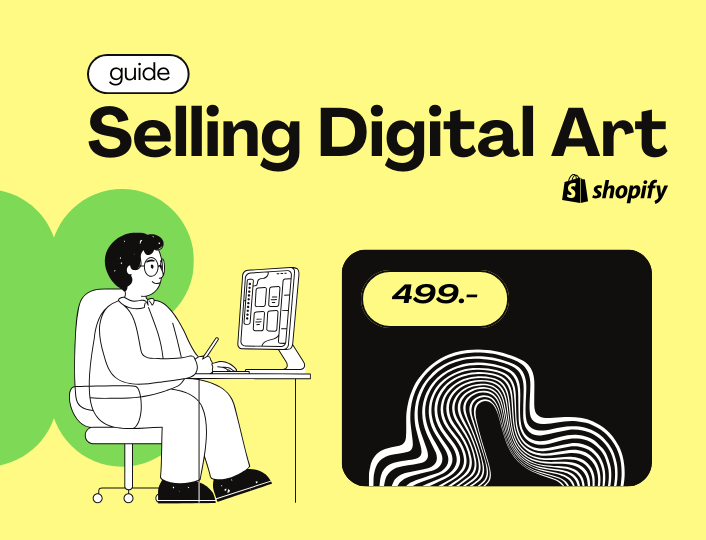How passionate are you about selling your art? Are you content with being an analogue artist selling to family and friends? Or to be a recognisable art brand worldwide?
To become a recognizable art brand is easy. Create an online presence and reach a broader audience. With Shopify, selling digital art is more accessible and profitable than ever. Whether you’re a seasoned artist or a beginner, this blog post will guide you through selling Digital Art on Shopify, including challenges and solutions.
Setting Up Your Shopify Digital Art Store
Here, are some essential tips for preparing your Shopify digital art store:
1. Choose Your Art Style
The first step in setting up your store is to choose your style of art. Ask questions like:
- What brand of art do I want to showcase in my store – digital paintings, graphic designs, drawings, or illustrations?
- How easy would it be to sell these arts to clients? Can I describe them in a way they can understand?
- What’s the profit margin on each of these different brands?
Whatever style you choose should be unique and appealing to your target audience. A consistent art style will help you build your brand and grow your followership.
2. Create Your Shopify Store
To get started with Shopify, you need to:
- Sign up for an account on the Shopify website.
- Choose a pricing plan within your budget
- Select a unique and memorable name and domain that represents your brand
- Choose a Shopify theme that complements your style and art style
- Customize it to your preferred taste
Ensure to create a user-friendly store that is visually appealing and easy to navigate.
3. Install a Digital Downloads App
To upload digital products in the Shopify art marketplace, you need a digital download app. Thankfully, Shopify has its free download app. For unlimited options and functionality, you can choose other digital download apps from the Shopify app store.
4. Add Products
Once the digital download app is done, create a product page from the Shopify dashboard and upload your digital art files to your store. Ensure it is marked as products by the product editor as they will be seen as the products you sell.
Digital product information is of utmost importance when selling art online, therefore ensure to add detailed descriptions, pricing and product variations when necessary.
5. Choose High-Quality Images
No compromises on quality. The art image is the only conviction you need to appeal to your customers; keep it of the highest quality. High-resolution files can be printed on various mediums, expanding your product offerings.
6. Set Up Payment and Shipping
Configure payment gateways and shipping options to accommodate your customers’ needs. Here are some of the best Shopify payment methods for your store.
Legal Aspects of Selling Digital Art
Digital products can be easily copyrighted. Here are some measures to protect your art against copyright infringement.
- Use Watermarks – Watermarks are symbols, text or patterns that are intentionally superimposed on another image to prevent illegal use or duplicates. Watermark your digital art, even after purchase, to protect it from unauthorized use.
- Terms and Conditions – This defines a rule, specifications and requirement of a contract that a consumer must adhere to when in possession of a product. Clearly outline your terms and conditions for the use of your digital art.
- Copyright and Intellectual Property – Educate yourself on copyright laws and IP infringement laws to protect your work and intellectual property. Refer to this article for more insight into copyright and intellectual property.
- Offer Licensing Options – Sell different types of licenses for your digital art, specifying how buyers can use the files.
- Digital Rights Management Tools – Explore DRM tools and services to add an extra layer of protection to your digital files.
Marketing Your Digital Art
Leverage the power of social media platforms to showcase your art. Be consistent in showing your artwork on your social media pages, engage with your followers and use relevant hashtags to expand your reach. Additionally, use paid adverts on platforms like Facebook and Google to reach a broader audience.
For your website, you can optimize your Shopify store for search engines using relevant keywords in product descriptions and blog posts. Also, use relevant email marketing tools to build your email list and send newsletters to your subscribers, promoting new art releases, special discounts and exclusive content.
Success Stories and Case Studies
We figured you could use some persuasion, so we dug up some success stories of digital art sellers on Shopify. Let’s begin with
Or Many Fine Art Photography
Or Many Fine Art Photography is a digital art store on the Shopify platform that sells its unique vision and artistic experience.
This Shopify brand name is named after the artist, Or Many, a landscape and wildlife photographer from Tel Aviv. He was passionate about this work and vision until 2016 when he had an accident that left him in a critical condition and resulted in the amputation of his right hands.
Despite this setback, Or kept a positive mindset to rebuild his career and passion. Faced with multiple challenges Or continued creating art with the use of the latest technology and advanced research.
In 2018, he opened one of the first fine art photography galleries in Israel One year later, Or opened the largest printing lab in Europe for manufacturing art on HD Metals and other materials to provide the best printing solutions for all types of artists.
Presently, he owns Or Many Photography, a digital art Shopify store that sells its digital art and uses Adoric to improve conversion and grow sales.
Amira Rahim
Amira Rahim saw art as a hobby until she watched “The Art of Getting By” which transformed her perception of art. Since then, she has committed to creating spectacular art pieces.
Now, she focuses on creating abstract art that interprets her emotions and tells her story. Although she encounters challenges that slow her progress, she always tries to keep a positive mindset, trusting the process.
In her words, “ Painting is my way of honouring my time on earth. It’s my way of paying homage to the human experience. And it’s a process that moves me every day.”
Amira Rahim is the brand name for her Shopify digital art store that sells digital art prints, print bundles and art accessories for an artist.
Matt LeBlanc
Matt LeBlanc never actually started as an artist. He graduated from a marketing program and worked as an account executive for an advertising agency. However, he was always drawn to the art store on his way to work and often found himself daydreaming about learning how to paint.
This curiosity drove him to an art store where he came across a man who taught him about brush quality, palettes, knives and paints. This birthed his art career.
He started from his basement and within five years became a full-time artist and officially became Matt LeBlanc, a prestigious art brand. He has moved on to become one of the most popular and appreciated artists in Atlantic Canada and has sold over 4,000 paintings.
Matt’s art is unique and easily recognisable in homes and offices locally and is owned by well-known designers like Debbie Travis from the TV show Dragon’s Den. Matt believes that you should think of yourself as a brand and never be afraid to take chances and risks.
Every business comes with its risks and challenges, digital art is no exception. Let’s cover some of the challenges of selling digital art online and how to resolve them.
Challenges of Selling Digital Art and its Proffered Solutions
While selling digital art has its advantages, it also comes with its unique set of challenges. They are not limited to:
Copyright and Plagiarism Concerns
One of the utmost challenges in the digital art market is protecting one’s intellectual property. Digital art is easily reproducible, making it susceptible to copyright infringement and plagiarism. Artists often find it challenging to maintain control over their work, as digital files can be duplicated and distributed without permission.
Solution: Register your work with relevant copyright authorities to establish legal protection. Clearly state your copyright terms on your website or sales platforms, and include a digital rights notice in your art files. When pursuing legal action, consult with a lawyer who specializes in intellectual property to ensure you can defend your rights effectively.
Provenance and Authenticity
Proving the authenticity of a digital artwork can be difficult. Unlike traditional art with physical signatures and historical records, digital art may lack a clear chain of ownership, which can make buyers hesitant to invest in it.
Solution: Protecting your digital art from piracy requires a multi-faceted approach. Use watermarks to protect your work against theft and employ digital rights management tools to restrict access. Collaborate with platforms and marketplaces that have robust copyright protection measures in place.
Monetisation and Revenue Generation
Determining the right pricing strategy for digital art can be challenging. Artists must balance the desire for accessibility to a broad audience with the need to receive fair compensation for their creative efforts.
Solution: Research the market and analyze the pricing strategies of successful artists with similar styles and experience. Consider factors such as the size and complexity of your work, the demand for your art and your level of expertise. Experiment with different pricing models such as limited edition releases, and auctions. Adjust as you gather feedback and data.
Market Saturation
Daily, countless artists crowd the digital market space, vying for the attention of potential buyers. Standing out in this space can be difficult if you’re just establishing your brand.
Solution: to cut through the noise, focus on building unique brands and styles. Develop a signature style that sets you apart from the competition. Engage with your audience through social media, art communities and blogs to create a loyal fan base. Explore niche markets and art-related platforms, which can help you connect with the right audience more effectively.
Changing Trends and Technology
The digital art landscape is constantly evolving. New tools, platforms and trends emerge regularly, requiring artists to adapt and stay updated, which can be both time-consuming and overwhelming.
Solution: Join art communities to plug into updates on tools and resources. Consume art blogs and set notifications to catch updates from your communities. Work efficiently to incorporate new trends and update technology in your art pieces.
Conclusion
Selling digital art on Shopify is a fantastic opportunity to turn your passion into a thriving business. With the right preparation, marketing, and customer service, you can build a successful online presence and share your creative vision with the world.
Start now! Set up your Shopify store and turn your passion into a thriving online business.




